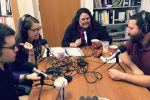Throughout its 13-year history, Mayyim Hayyim Living Waters Community Mikveh and Paula Brody & Family Education Center has been dedicated to the principle of petichut (Hebrew for “openness” and “inclusivity”). Anyone in the Jewish community who wants or needs to partake in a ritual immersion has a mikveh, or ritual bath, to use.
While pre-wedding, monthly niddah (purification) and conversion immersions take place several times a week, Mayyim Hayyim is also a place to heal, mark transitions and acknowledge milestones. Over the years, the center has produced myriad ceremonies for everything from coming out to becoming a bar or bat mitzvah. Its innovation and creativity have been lauded and implemented in mikvehs across the country and the world.
With a recent grant from the Ruderman Family Foundation, Mayyim Hayyim deepened its long-standing commitment to inclusion by opening its two mikvehs in even more meaningful ways to people with developmental disabilities. The grant led to a short video called “Open Waters: Mikveh for Everybody,” a companion guide of the same name and a new, simplified version of Mayyim Hayyim’s guided meditations and kavanot (preparatory intentions) for mikveh preparation.
The cornerstone of mikveh preparation, kavanot (singular: kavana) are a combination of English and Hebrew phrases that can be daunting for a person with cognitive or developmental disabilities. The new guide, “7 Things to Think About and Do To Get Ready for the Mikveh: A Simple, Pictorial Version of Mayyim Hayyim’s 7 Kavanot for Mikveh Preparation,” is pared down from its predecessor.
For example, the first kavana asks the person immersing to meditate on the word Hineini (“Here I am”). This kavana is accompanied by instructions to help someone situate him or herself emotionally and physically in the mikveh:
Take a minute and think about the transition the mikveh will help you mark today.
Immersion in the mikveh represents a spiritual transformation from one state to another. In traditional language, your change is from ritually unready (tameh) to ritually ready (tahor). Prepare yourself by writing in a journal, or saying a personal prayer, or reading something of meaning to you. Breathe deeply. Sigh audibly.
As in the previous version, Hineini is transliterated and written in Hebrew. The page is illustrated with two silhouettes of a man or a woman and encourages someone to declare:
Here I am.
I have come to the mikveh today to focus on an important time in my life.
The step-by-step directions are straightforward:
Take a deep breath in and out.
Look in the mirror and say, “I am here.”
Lisa Berman, mikveh and education director, said: “The most challenging part of preparing the pictorial guide were the visuals. We didn’t want to have photographs showing gender, race or age. We tried to use some of the iconography in books and guides for people with disabilities, but many of them were too pediatric. We wanted this to appeal to all ages and levels. Our graphic designer, Josh Meyer, came up with the idea of taking a photograph and inking it out.”
In addition to Meyer’s participation in the project, cantor Rachel Stock Spilker, Mayyim Hayyim’s scholar-in-residence in 2016, wrote much of the content. Stock Spilker maintained the Hebrew so people would have the opportunity to engage fully with the language and the words.
Related
Rebecca Redner, a program associate at Gateways: Access to Jewish Education, and Nancy Mager, the organization’s director of Jewish education, consulted on the project. “Mayyim Hayyim,” said Redner, “did something universal not only for people with disabilities, but also for people who don’t necessarily speak English.” Redner noted that as she went through the guide, she was mindful of simplifying the language “without making it juvenile. We wanted to bring it to a level to where anyone reading it could understand it.”
The new kavanot guide and “Open Waters: Mikveh for Everybody” video, produced by Jen Kaplan of Spencer Films in Newton, have also been jumping-off points for the curricular publication discussion. In her introduction to “Open Waters,” Mayyim Hayyim’s executive director, Carrie Bornstein, writes how the curriculum is designed to be “an educational tool for your own community to explore how barriers can be minimized and even removed in the varied settings of Jewish communal life. If we can make an environment as challenging as a mikveh accessible to people with disabilities, shouldn’t we all be able to do as much elsewhere?”
Berman added that the “Open Waters” video and guide were produced to inspire synagogues and other groups to “take a step back and think about inclusivity. It asks someone to walk around a space with an imagined disability and interact with your space. And it also asks what does it mean for someone to feel outside of an inner circle? That goes way beyond the issue of physical disability.”
This post has been contributed by a third party. The opinions, facts and any media content are presented solely by the author, and JewishBoston assumes no responsibility for them. Want to add your voice to the conversation? Publish your own post here. MORE





